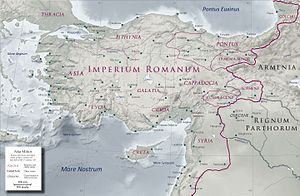
Back مملكة كوماجيني Arabic کوماژن AZB Камагенскае царства Byelorussian Комагена Bulgarian Kraljevstvo Komagena BS Commagena Catalan Kommagene Czech Kommagene German Κομμαγηνή Greek Reino de Comagene Spanish
Commagene Κομμαγηνή | |||||||||
|---|---|---|---|---|---|---|---|---|---|
| 163 BC – 72 AD | |||||||||
 | |||||||||
| Capital | Samosata | ||||||||
| Common languages | Greek (official)[1] Persian (ruling dynasty)[2] Local Aramaic language | ||||||||
| Religion | Greco-Iranian religious syncretism[3] | ||||||||
| Government | Monarchy | ||||||||
| King | |||||||||
• 163–130 BC | Ptolemaeus | ||||||||
• 38–72 AD | Antiochus IV | ||||||||
| Historical era | Hellenistic Age | ||||||||
• Established | 163 BC | ||||||||
• Disestablished | 72 AD | ||||||||
| |||||||||
| Today part of | Turkey | ||||||||

Commagene (Greek: Κομμαγηνή) was an ancient Greco-Iranian kingdom ruled by a Hellenized branch of the Iranian Orontid dynasty that had ruled over Armenia.[4] The kingdom was located in and around the ancient city of Samosata, which served as its capital. The Iron Age name of Samosata, Kummuh, probably gives its name to Commagene.[5]
Commagene has been characterized as a "buffer state" between Armenia, Parthia, Syria, and Rome;[6] culturally, it was correspondingly mixed.[7][8] The kings of the Kingdom of Commagene claimed descent from Orontes with Darius I of Persia as their ancestor, by his marriage to Rhodogune, daughter of Artaxerxes II who had a family descent from king Darius I.[9][10] The territory of Commagene corresponded roughly to the modern Turkish provinces of Adıyaman and northern Antep.[11]
Little is known of the region of Commagene before the beginning of the 2nd century BC. However, it seems that, from what little evidence remains, Commagene formed part of a larger state that also included the Kingdom of Sophene. This situation lasted until c. 163 BC, when the local satrap, Ptolemaeus of Commagene, established himself as an independent ruler following the death of the Seleucid king, Antiochus IV Epiphanes.[12]
The Kingdom of Commagene maintained its independence until 17 AD, when it was made a Roman province by Emperor Tiberius. It re-emerged as an independent kingdom when Antiochus IV of Commagene was reinstated to the throne by order of Caligula, then deprived of it by that same emperor, then restored to it a couple of years later by his successor, Claudius. The re-emergent state lasted until 72 AD, when the Emperor Vespasian finally and definitively made it part of the Roman Empire.[13]
One of the kingdom's most lasting visible remains is the archaeological site on Mount Nemrut, a sanctuary dedicated by King Antiochus Theos to a number of syncretistic Graeco-Iranian deities as well as to himself and the deified land of Commagene.[14] It is now a World Heritage Site.[15]
- ^ Shayegan (2016), p. 13.
- ^ Ball (2002), p. 436.
- ^ Shayegan 2016, p. 13; Ball (2002), p. 436; Strootman (2020), p. 214
- ^ Canepa 2010, p. 13; Garsoian 2005; Erskine, Llewellyn-Jones & Wallace 2017, p. 75; Canepa 2015, p. 80; Sartre 2005, p. 23; Widengren 1986, pp. 135–136; Merz & Tieleman 2012, p. 68; Ball 2002, p. 436; Shayegan 2016, pp. 8, 13; Strootman 2020, p. 205; Facella 2021; Michels 2021, p. 485; Toumanoff 1963, p. 278; Gaggero 2016, p. 79; Allsen 2011, p. 37; Olbrycht 2021, p. 38; Drower et al. 2021; Ferguson 2021, p. 170; Boyce & Grenet 1991, p. 309; Vlassopoulos 2013, p. 312; Crone 2012, p. 351; Graf 2019, p. III; Jacobs & Rollinger 2021, p. 1660; Russell 1986, pp. 438–444; Spawforth 2016; Sherwin-White & Kuhrt 1993, p. 193; Campbell 2015, p. 27
- ^ Blömer & Winter (2011), p. 142.
- ^ Lang (1983), p. 510.
- ^ Lang (1983), p. 535.
- ^ Cite error: The named reference
merlat3was invoked but never defined (see the help page). - ^ Cook, J.M. (1993). The Persian Empire (Repr. ed.). New York: Barns & Noble Books. pp. 170, 173, 193, 212, 213, 216, 217, 221–223, 257, 263. ISBN 978-1-56619-115-9.
- ^ Hovannisian, Richard G. (1997). The Armenian People from Ancient to Modern Times - 2 Vols. St. Martin's Press, New York.
- ^ Blömer & Winter (2011), p. 13.
- ^ Cite error: The named reference
Sartre, M. 2007 p. 23was invoked but never defined (see the help page). - ^ Hazel, J. (2002). Who's Who in the Roman World. Psychology Press. p. 13. ISBN 9780415291620. Retrieved 20 February 2014.
- ^ Blömer & Winter (2011), pp. 10–11.
- ^ UNESCO World Heritage Centre. "Nemrut Dağ". Retrieved 12 October 2017.
© MMXXIII Rich X Search. We shall prevail. All rights reserved. Rich X Search